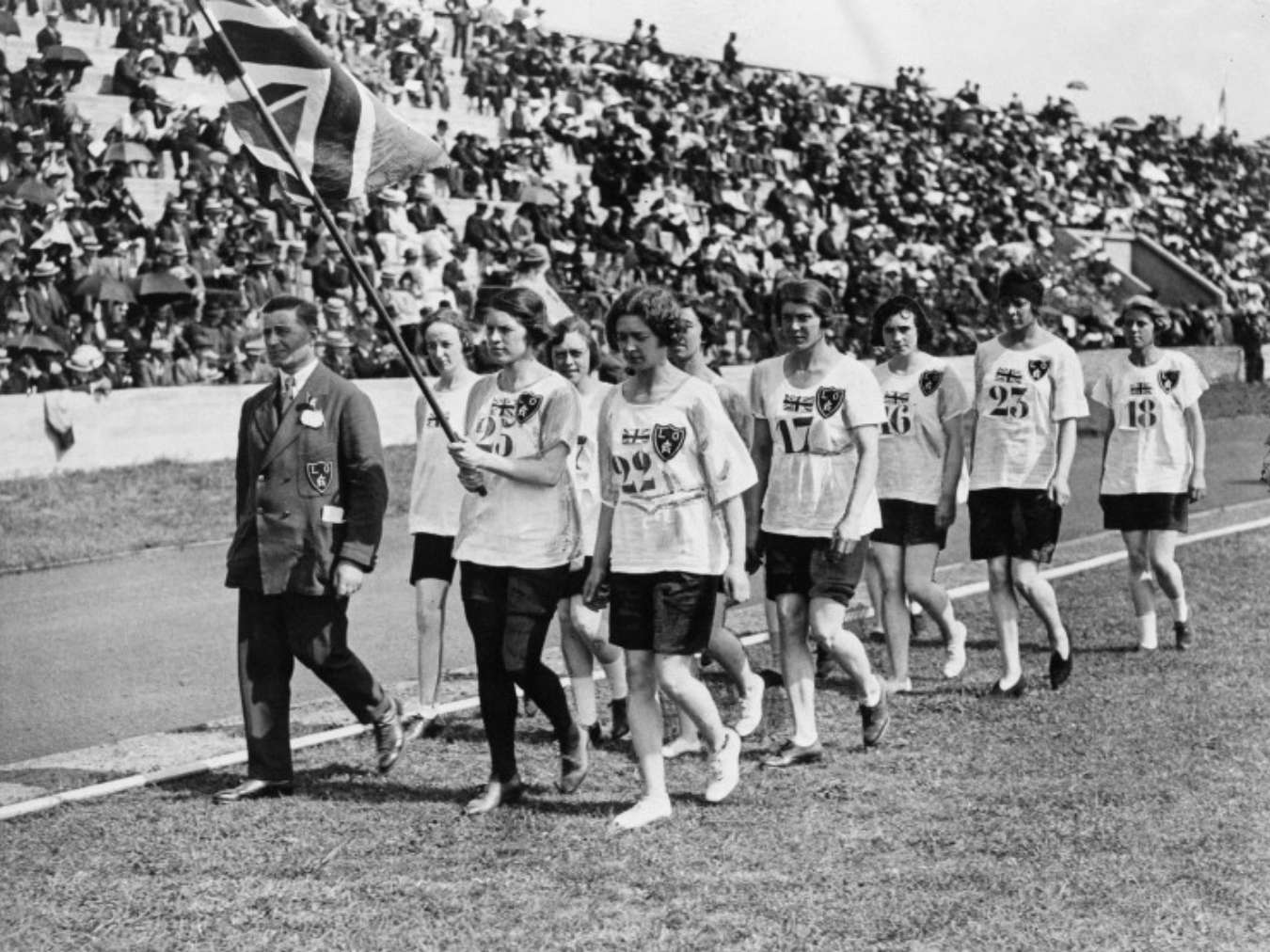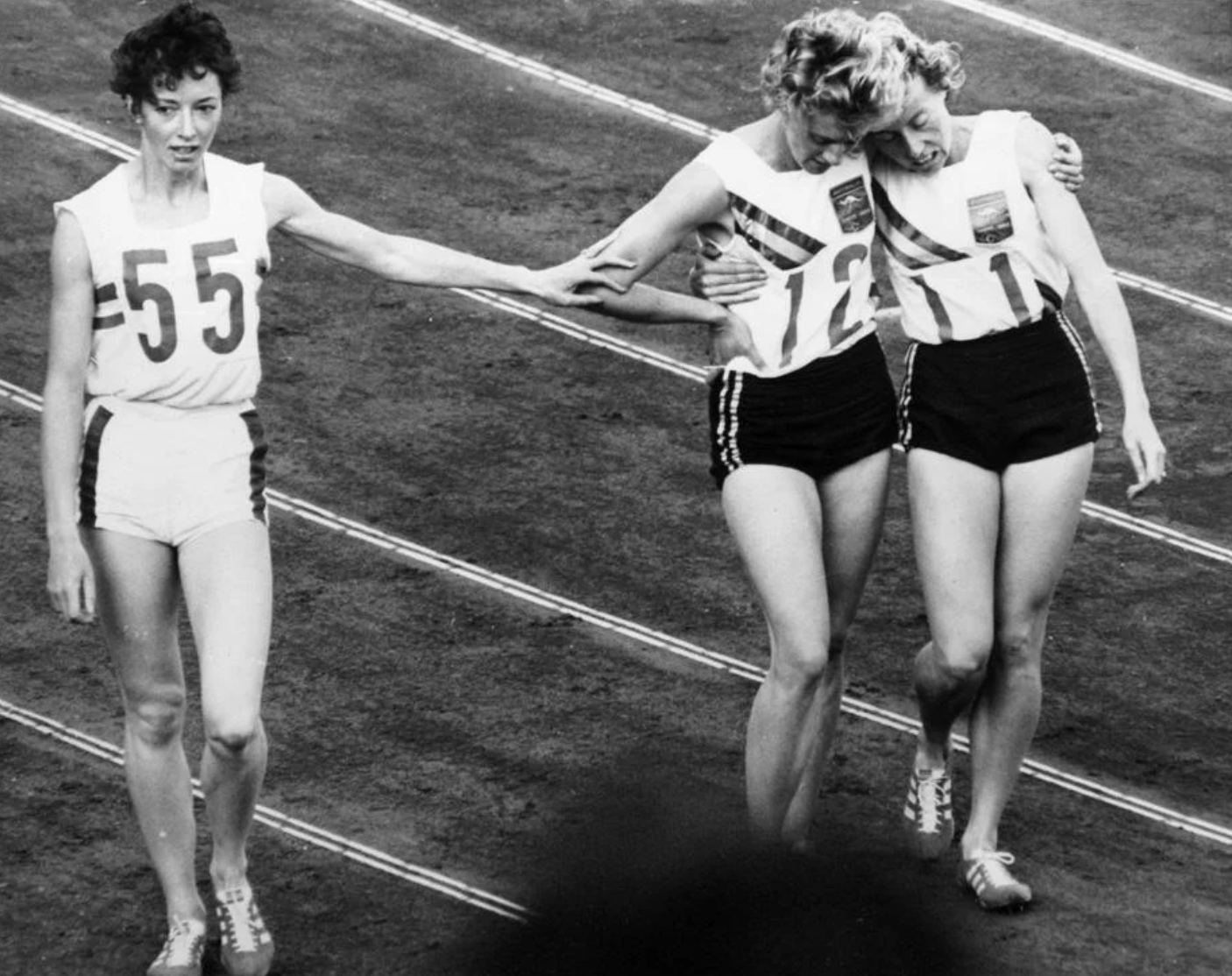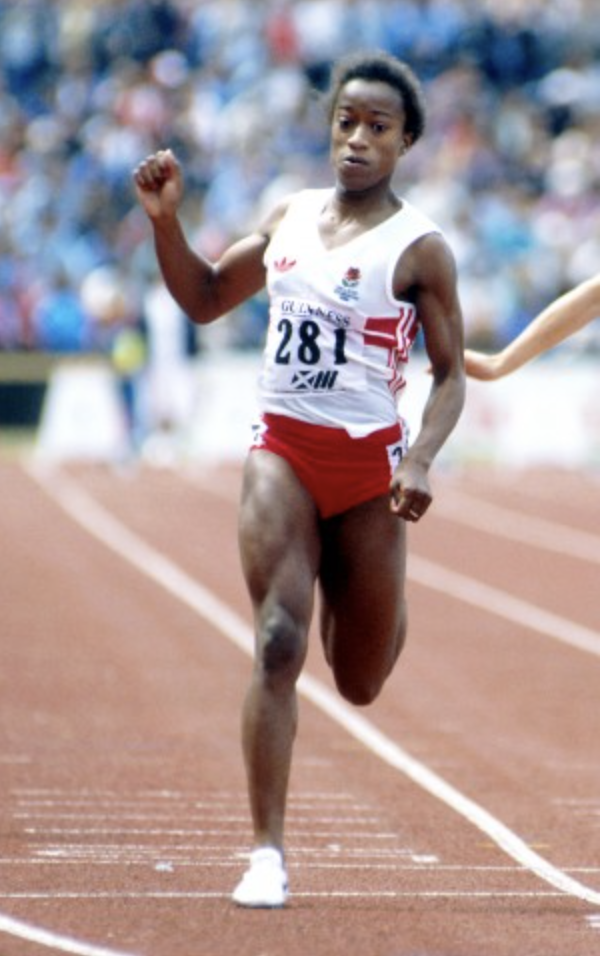
Author: Gwenda Ward is a Track & Field Coach based in Cumbria, North of England, who dedicates her life to the betterment of the sport of athletics and it’s coaching. Gwenda represented Great Britain at the first Tokyo Olympic Games in 1964, competing in the high jump and went on to compete the high jump and long jump, at the 1966 British Empire and Commonwealth Games in Kingston, Jamaica. Having remained in the sport ever since, Gwenda has continued to challenge the status quo and fought for better treatment of female athletes and young athletes. Gwenda is now undertaking a professional doctorate at Liverpool John Moores University (North West England) researching the integration of mental skills into coaching with development stage athletes.
Gender equity in athletics – Where’s the problem?
Athletics has a proud record of promoting positive images of women in sport – and British track and field athletes have played a major role in that process back through the decades. But behind the headlines, women’s athletics, alongside women in sport as a whole, has struggled hard to gain that elusive goal – equality. But, in specific terms, what does that mean, and is it even on the sport’s agenda in 2021?
Over the years, the global performance profile of British athletes has fluctuated markedly by gender. In the 1964 Olympics, our women’s team was far superior in terms of world ranking, yet by the 1980s the opposite was true to an extreme degree. Today, our three best medal prospects for Tokyo 2020/1 are female (Asher-Smith, KJT, Muir). Does this mean that unequal access to world success is now history, and if so, is this a result of improved conditions for all girls and women in the sport or merely for the elite? Then again, it could be just a statistical blip indicating nothing of particular significance for gender at all.
In order to think about all this, it may be useful to acknowledge some of the historical meanderings that got us to where we are in 2021. The first challenge, at around the turn of the 20th C when female suffrage and women’s rights were high on the political agenda, was simply equal access to an area of life – sport – which was, and some would say is still, seen as a fundamental expression of maleness. In 1923, The Amateur Athletics Association, already established for 43 years, advised the newly formed Women’s AAA that they would be better off on their own – although they were later granted affiliated status. This was in a period when recreational sport for the masses was becoming established, including school sport for girls. Indeed, professionally trained female physical education teachers, some of whom had competed in the Women’s World Games, had strong influence in both boys’ and girls’ PE in the 1920s. It was those same women who, having trained in PE at Regent Street Polytechnic, set up London Olympiads AC, which once dominated women’s athletics and only faded from the scene in the late 90s.
Never-the-less, predominant opinion in the early 20th C still saw sport for women as “unfeminine”, and medical opinion reinforced this by asserting that severe physical exertion could damage women’s fertility – a fascinating example of how culture can completely mask scientific objectivity. I can remember my mother telling me that, as a girl she had been identified as a promising hurdler at school, but her mother had forbidden her to join Ealing Olympic Ladies AC in case she did herself damage. That would have been in the late 20s or early 30s – an example of how stepping outside the conventions of “feminine behaviour” constrained young women, even though, objectively, opportunities were there. Come to think of it, can we be sure that this is not still happening now by other means, such as social media?
Joan Balasco high jumped 1.62 (5ft 4ins) over a bamboo cane in 1920, Violet Percy ran a marathon in 3.04.22 in 1926 and Nellie Halstead ran 56.8 for 440 yards in 1932?
At international level the IOC had rejected pleas for women’s events to be included in the Antwerp Olympics (1920), leading to the formation of the Federation Sportive Feminine Internationale and the staging of the first “Women’s Olympics” in 1921. The IOC promptly banned the FSFI from calling their championship an “Olympics”, after which a Women’s World Championships/Games was held by the FSFI every four years until 1934. However, by the Amsterdam Olympics in 1928 the IOC deemed it acceptable to include five women’s events. (100m, 800m, 4 x 100 relay, high jump and discus) That was the Games that, according to the BOA and The Times, saw women collapsing right, left and centre after the 800, so “proving” that “the ladies” were too fragile to run that distance. Although there is little evidence of these reported collapses, the 800 was subsequently banned for women until 1960.

By the Tokyo Olympics in 1964, women were allowed to take part in 12 events – 100m, 200m, 400m (for the first time), 800m, 80m hurdles, 4 x 100m, high and long jumps, shot, discus, javelin and pentathlon, as opposed to the standard 24 for the men. As I was one of the high jumpers in that team alongside Frances Slaap, who finished 6th, and Linda Knowles, (incidentally, this was the last time that Britain had three female high jumpers in an Olympics!) I can say with confidence that this apparent unfairness was totally taken for granted at the time, including by me. That 1964 athletics team won more medals than any other Olympic team since (apart from Los Angeles, 2004, which was boycotted by the Eastern Bloc), with the women winning 5 (2 gold, 2 silver 1 bronze) from their 12 events and the men winning 7 (2 gold and 5 silver) from their 24 events. Years later I worked out that the average world ranking of that 1964 British women’s team was 15, whilst the men’s average in the same events was in the 50s. But no-one, least of all the athletes, noticed how good the women were in global terms at the time, admittedly in an era prior to the global uptake of sport for women. Interestingly, the emergence of the Soviet Union as a dominant force in world sport was noticed, as were the support mechanisms that were built into their national system. As a consequent the British Sports Council was set up in 1965, firstly as an advisory body, then fully constituted in 1972.

Many years later I became very aware of the second equity challenge – that of equal access to success – and this is where the complexity manifests itself. The 1980s were a “golden decade” for the sport, underpinned by commercialization, massive TV contracts, large sponsorship deals and subvention (appearance) payments for athletes.
It was the change away from the traditional (somewhat tedious) dual international model of competition to the now familiar invitation “spectaculars” designed for TV that paved the way for this success. This concept of “invitational” international meetings was initiated by Alan Pascoe while he was still a student at Borough Road College, ably assisted by a certain Mr Andy Norman, later contracted by BAF to direct all their promotions. (I find it salutary that this revolutionary change was in fact the NGB’s response to external events, rather than the enactment of a corporate vision)
The sport boomed and a series of athletes became household names – Coe, Ovett, Cram, Christie, Regis, Jackson, Jarrett, Thompson, Moorcroft, Whitbread, Sanderson, and later Gunnell and Radcliffe, seemingly thriving on the new “bums on seats” philosophy of Andy Norman, who revolutionised the competitive opportunities available to our top athletes at that time.But there was a pay-off. Apart from championships, the major competitions had become commercial outlets for the sport, meaning that the competitive needs of athletes had to be balanced against what was judged to be compelling for the media. In general, the men thrived, but the women languished in comparison. Female stars such as Fatima Whitbread and Tessa Sanderson did make it to the top, but they were vastly outnumbered by the men. It is very telling that, by 1990, only 2 British women featured in world top 10 rankings, compared to 12 men (Peter Matthews, Athletics 1991, ATFS).
This contrast in attainment was so extreme and so different to the situation in 1964, that, even considering some global levelling up for women and the impact of drug abuse, it had also to be indicative of a systemic contrast in opportunity between the sexes in this country. But the sport was not thinking in these analytic terms and, in the same way that no-one noticed the superior quality of the ‘64 women’s team, 26 years later no-one appeared to register that the women had fallen behind, let alone to what extent. The women’s lower profile and success rate was simply accepted as the norm; a case, I would suggest with hindsight, of extreme organisational sexism. This may have been reflective of prevailing attitudes at the time, but it was an opportunity lost never-the-less. A trend, after all, only provides an opportunity for insight once it is recognised as a trend.

In the late 80s, I started to write and lobby on gender equity in order to raise awareness of this endemic unfairness, pointing out that the market forces philosophy gave the women less access to high level competition, which seriously disadvantaged them financially (this was pre-lottery funding for individual athletes) and rendering their opportunities to become full-time athletes virtually zero. Furthermore, I guessed that their every-day perception of second-class athletics citizenship, in what appeared to be an extremely “macho” culture within the governing body at the time, would have an impact on them psychologically. Conversations with athletes tended to confirm that self-confidence and self-esteem had indeed been undermined, and that this may well have further undermined performance.
As the result of all this a lot of action was taken. I was asked by BAF to set up a Women’s Advisory Group (WAG). I was introduced to sport psychologist Alma Thomas who confirmed the likely negative impact of the perception of “second-class-citizenship” on female performance. We surveyed 120 elite and elite potential female athletes for their views and experience, we lobbied, we wrote reports – and eventually our proposal to run mental preparation courses for female athletes and their coaches was accepted by BAF. The courses ran during the winters of 92/93 and 93/94 and were, according to the feedback from both athletes and coaches, wildly successful.
The following June the qualifying round of the World Cup took place in Birmingham, with 10 women who had attended the courses selected to compete. The Guardian’s report (John Rodda, 27th June 94) started thus:
“Britain’s women savoured their finest hour since the 1964 Olympics here yesterday when they, as well as the men’s team, qualified for the world Cup finals at Crystal Palace in September.”
While it is obviously problematic to ascribe improved performance to any one single aspect of preparation, the athletes themselves made the connection to the courses, and said so publicly. However, the BAF declined to fund the programme further, claiming it was “too expensive”. But as David Powell of The Times pointed out, the GB women’s presence at the World Cup Final would likely boost the gate takings massively and a sell-out (not unusual in those days) would net them £750,000, so the logic regarding cost was hard to follow. Neither was the possibility of reducing costs (or the outcomes of the programme, which we religiously reported) ever discussed with any member of the Women’s Advisory Group.
I cannot say categorically why BAF declined to continue to fund, or even discuss, this work, but informal feedback suggested that some of the top coaches of the time were uncomfortable with even considering the psychological dimensions of coaching and performance in this way – judging that that it would “interfere with the coach/athlete dynamic”. Some even banned “their” athletes from attending the courses. Also, though, I can’t help thinking that somehow the power dynamics between the exclusively male decision makers of BAF, an exclusively male coaching hierarchy and a group of female volunteers appointed to “advise” on a topic not usually seen as relevant in the sport at all, played a part. But I’ll never know.
However, clearly the performance implications of sport psychology for both sexes were not lost on BAF, who, after denying the courses a future, engaged Alma Thomas as travelling sport psychologist for the next three Olympics. The WAG group took some consolation from this but were frustrated that the gender disadvantage and athlete development implications of the programme had been ignored.
The Women’s Advisory Group struggled on for another couple of years, gaining some funding for courses from Sir Eddie Kulukundis, but without the committed backing of the BAF on this and related issues (e.g., women in coaching and decision making), there seemed little point in it continuing, particularly after Lottery funding was introduced for elite athlete support in 1994. So, at that point, all attempts at direct action to address gender disadvantage died.
Then in 2002/3, England Athletics introduced a Valuing Diversity project which encompassed BAME, Disability and Gender, as they were required to do by Sport England. I was asked to chair the gender group, and so, thinking that maybe times had changed, I gathered another dynamic and committed group of women together to thrash out a sport wide action plan. Our plan encompassed all areas of work that we viewed as necessary in order of priority, including comprehensive data tracking on participation and performance trends as the basis for action, the identification of good practice relating to sustained participation and its circulation to clubs and coaches, the provision of sport psychology, the identification of barriers to and action on female advancement in coaching and decision making (the sport had funding for this from Aqua Pura), tapping in to academic research on coaching female athletes – and so on. In other words, we envisioned the plan as a collaborative effort across the sport in recognition that many grey areas remain, so let’s explore them as a community in order to break exciting new ground.
So, what happened, I hear you ask. Well, dear reader, I’d say the outcomes veered somewhere between very little and absolutely nothing. Firstly, the gender plan was amalgamated with those for BAME and disability, rendering it all but invisible. The Aqua Pura funding was used to set up “centres of excellence” for gender, but with no over-arching principles or objectives attached. Once the funding ceased the centres died, leaving nothing in their wake. Some support groups for the advancement of women in coaching where set up (presumable on a “deficit” rather than a “barrier” model of under-representation), but it is very unclear to me whose, if anyone’s, coaching career was advanced as a result. Certainly, female coaches at the professional level are still notable by their absence and little or no lasting impact has resulted from either the WAG or the EA initiatives.
So, where are we now? Clearly the introduction of objective criteria for Lottery funding has enabled the careers of some female talent to flourish. But this change was initiated by UK Sport, not from a perception of unfair treatment from within athletics. Changes benefitting women in our sport have frequently, if not always, been the unplanned outcome of external events, not of a deliberate equity strategy. Some might argue that the integration of the men’s and women’s associations and the competitive structure was exactly that, but, although there have been significant benefits in terms of organisation, image, finance and feeling of inherent “rightness” from that integration, few benefits in terms of the expression female potential are evident. Still, only about a third of participating track and field athletes in the 20 to 34 age range are female, a ratio that has not changed since the 80s. Again, there seems to be an assumption that this loss is inevitable – therefore how we might lessen drop-out (for both sexes and specifically for young women), has not been purposefully investigated across the sport, even in coaching.
There is a concept in sociology called “closed circle thinking” in organisations, where what counts as relevant knowledge becomes, unconsciously and over time, mere dogma to be tightly defended against any dilution from outside the power group that maintains it. Given the extreme complexity involved in the unravelling all of the above, and other influences on historic female under-achievement in sport such as social class, such a response maybe an understandable defence against questioning, exploration, openness and the consequent uncertainties of change. But athletics is fundamentally about the acceptance of challenge; as individuals, we thrive on it. Maybe it’s time we responded collectively in order to challenge one of history’s most dominant themes, that of the suppression of female potential.